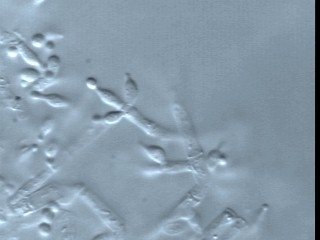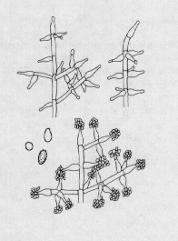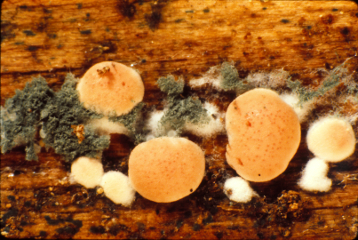Main page <> Index of descriptions <> Previous description <> Trichoderma <> Next description
Trichoderma



Usually recognized by fast-growing colonies producing white, green, or yellow cushions of sporulating filaments. The fertile filaments or conidiophores produce side branches bearing whorls of short phialides. The 1-celled spores (conidia) are produced successively from the tips of the phailides and collect in small wet masses. The photograph at left, and the drawing, show a species of Trichoderma as seen with a microscope, but Trichoderma species are also very conspicuous in the field, especially under the dead bark of trees. The photo at right shows a species of Trichoderma producing its green conidia among the nearly mature cushion-shaped stromata of its teleomorph.
Trichoderma species are strongly antagonistic to other fungi. The exact nature of this relationship is still not clear, but it appears that they kill other fungi with a toxin and then consume them using a combination of lytic enzymes. This suggests they are actually microbial predators. This antagonistic behaviour has led to their use as agents of biological control of some fungi causing plant disease. On the other hand, they can be serious pests in cultivated mushroom beds. Species of Trichoderma are common in soil (especially water-logged soil), dung, and decaying plant materials.
Classification: Hypocreaceae. Holomorphs: Hypocrea, Podostroma. Ref: Bissett, 1984, 1991a,b,c; Chaverri and Samuels, 2003; Gams, 2006; Rifai 1969; Samuels et al., 1998.